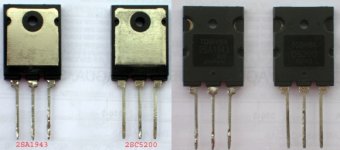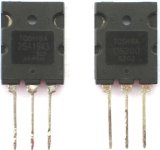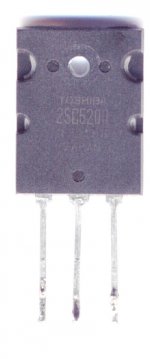No further Action!
I firmly believe Farnell did receive back the fake parts. As a big company they don't have to sign mail personally. In other words this is their way out of this issue.
They say they have not received the parts back so they don't have to take further action. You have your money back so you cannot complain any more. Clever isn't it?
DO NOT send the check back!

Hello Graham,Graham Maynard said:Hi All,
Well on Saturday I received two envelopes;-
(1) My credit card statement showed that Farnell had actually refunded the parts cost to me. This is not clear from the issued 'Credit Note', and there still has not been any reply to my written complaint.
(2) A cheque arrived for the 'missing' Recorded parts that our Post Office still do not know they delivered without signature. Now I have to write another letter sending that back.
Oh for that simple life before everything became computerised. It really was far more efficient !!!
Cheers ........... Graham.
I firmly believe Farnell did receive back the fake parts. As a big company they don't have to sign mail personally. In other words this is their way out of this issue.
They say they have not received the parts back so they don't have to take further action. You have your money back so you cannot complain any more. Clever isn't it?
DO NOT send the check back!

More counterfeit 2SC5200 and 2SA1943 ?
Hello everyone!
This is my first post in this forum. What a great place to learn ! I just started in the world of diy audio and so far I can say I love it. Excited enough with my new hobby I decided to buy the legendary pair of Toshiba transistors: 2SC5200 / 2SA1943 to use in one of the amps I plan to build.
Well, even after reading a lot of threads in this forum regarding counterfeit Toshiba transistors I think I was another victim. Attached is the picture of the one of the pairs I bought from a local supplier. Could someone help me to identify if these are fakes ?
I will try to summarize what I discovered so it makes things easier for you guys:
* Physical construction / Packaging:
Physical construction seems pretty good, dimensions appear to match the ones specified in the datasheets (except for millimeter or so), including holes’ diameters, position and etc.
As you can see in the picture, all the writings are in a rectangle that is shinier than the rest of the package. It is seems that it was pressed with a hot mold or something like this. If you pass you nails over it you can “feel” the writings. From what I’ve read I don’t know if Toshiba has this practice.
I call you attention to the 2SC5200 model number: it is just “C5200”. Also it does not have “JAPAN” written on it as opposed to the 2SA1943. I also noticed that the heatsink of the 2SC5200 is opaque and all scratched as opposed to the 2SA1943 which is shiny and polished.
From the Toshiba datasheets I know they use 2 letters to represent hFE parameter: O and R – I don’t see either one stamped on them. Is that a real problem ?
* Electrical Measurements:
I don’t have any special instruments to help me out here except for a digital multimeter that can measure hFE, Capacitances and Diodes Voltage drop. Measuring hFE showed me a ridiculous 10 for one 2SC5200 and 7 for the other one (Is this a joke ??). For the 2SA1943 I found coherent values: 110 and 105 (within datasheet specification). Measuring Emitter-Base junction voltage drop I found 0,49 Volt for the 2SC5200 and 0,56 Volt for the 2SA1943. For some reason I don’t know, I couldn’t get a valid reading when measuring base-emitter and base-collector capacitances – maybe I am doing something wrong.
I am pretty sure that the 2SC5200 is a fake but I am not sure about the 2SA1943. I would like to hear you opinions. Are any simple circuits available to test these transistors so I know they are fakes before watching a whole amplifier to blow ? Any other suggestions to help identify, by inspection, if they are fakes ?
I am sorry for such a long post but I tried to present all the data I found.
Thank you very much !
Joao Pedro
Hello everyone!
This is my first post in this forum. What a great place to learn ! I just started in the world of diy audio and so far I can say I love it. Excited enough with my new hobby I decided to buy the legendary pair of Toshiba transistors: 2SC5200 / 2SA1943 to use in one of the amps I plan to build.
Well, even after reading a lot of threads in this forum regarding counterfeit Toshiba transistors I think I was another victim. Attached is the picture of the one of the pairs I bought from a local supplier. Could someone help me to identify if these are fakes ?
I will try to summarize what I discovered so it makes things easier for you guys:
* Physical construction / Packaging:
Physical construction seems pretty good, dimensions appear to match the ones specified in the datasheets (except for millimeter or so), including holes’ diameters, position and etc.
As you can see in the picture, all the writings are in a rectangle that is shinier than the rest of the package. It is seems that it was pressed with a hot mold or something like this. If you pass you nails over it you can “feel” the writings. From what I’ve read I don’t know if Toshiba has this practice.
I call you attention to the 2SC5200 model number: it is just “C5200”. Also it does not have “JAPAN” written on it as opposed to the 2SA1943. I also noticed that the heatsink of the 2SC5200 is opaque and all scratched as opposed to the 2SA1943 which is shiny and polished.
From the Toshiba datasheets I know they use 2 letters to represent hFE parameter: O and R – I don’t see either one stamped on them. Is that a real problem ?
* Electrical Measurements:
I don’t have any special instruments to help me out here except for a digital multimeter that can measure hFE, Capacitances and Diodes Voltage drop. Measuring hFE showed me a ridiculous 10 for one 2SC5200 and 7 for the other one (Is this a joke ??). For the 2SA1943 I found coherent values: 110 and 105 (within datasheet specification). Measuring Emitter-Base junction voltage drop I found 0,49 Volt for the 2SC5200 and 0,56 Volt for the 2SA1943. For some reason I don’t know, I couldn’t get a valid reading when measuring base-emitter and base-collector capacitances – maybe I am doing something wrong.
I am pretty sure that the 2SC5200 is a fake but I am not sure about the 2SA1943. I would like to hear you opinions. Are any simple circuits available to test these transistors so I know they are fakes before watching a whole amplifier to blow ? Any other suggestions to help identify, by inspection, if they are fakes ?
I am sorry for such a long post but I tried to present all the data I found.
Thank you very much !
Joao Pedro
Attachments
MikeB
Intersting, I didn't notice this different behavior regarding hFE of power NPN devices in relation to its complementary transistor. I just looked at the datasheet of the 2SC5200 and I notice what you talking about. According to the datasheet, at 25 ºC and Ic = 10 mA we have hFE = 80. I will have to check test conditions in the multimeter's manual but I am pretty sure the base current it uses is really small (order of micro-amperes) and it is appropriate to small-signal transistors.
My only concern is that with such low currents the 2SA1943 would also would have showed a lower gain. Or, for power PNP it is pretty much constant ?
Joao Pedro
Intersting, I didn't notice this different behavior regarding hFE of power NPN devices in relation to its complementary transistor. I just looked at the datasheet of the 2SC5200 and I notice what you talking about. According to the datasheet, at 25 ºC and Ic = 10 mA we have hFE = 80. I will have to check test conditions in the multimeter's manual but I am pretty sure the base current it uses is really small (order of micro-amperes) and it is appropriate to small-signal transistors.
My only concern is that with such low currents the 2SA1943 would also would have showed a lower gain. Or, for power PNP it is pretty much constant ?
Joao Pedro
Here's a translated link (ala Google) to the article posted earlier by Eva. Unfortunately, the images are blocked by Tripod, so you need to have both version open at the same time.
http://translate.google.com/transla...fe=off&ie=UTF-8&oe=UTF-8&prev=/language_tools
-b
http://translate.google.com/transla...fe=off&ie=UTF-8&oe=UTF-8&prev=/language_tools
-b
Fake Device!!!
Hi jpnascim,
Sorry to say this but these are Absolute fakes, I have These 5200,1943 from diffrent companies of course Toshiba & Fairchild are available here Originals, working great with me, Toshiba never made with those type packages.
Normally the Hfe remains in the region of 47 - 120 for these transistors ,TOOOOO!! lower Hfe Don't even try.
Thanks
Arasuk
Hi jpnascim,
Sorry to say this but these are Absolute fakes, I have These 5200,1943 from diffrent companies of course Toshiba & Fairchild are available here Originals, working great with me, Toshiba never made with those type packages.
Normally the Hfe remains in the region of 47 - 120 for these transistors ,TOOOOO!! lower Hfe Don't even try.
Thanks
Arasuk
I agree they are probably fakes, but not because of the package type. See here:
http://www.toshiba.com/taec/components/Datasheet/e001066.pdf
I would be weary of any transistor with an applied-looking label (black square).
-b
http://www.toshiba.com/taec/components/Datasheet/e001066.pdf
I would be weary of any transistor with an applied-looking label (black square).
-b
It is so sad to see that suppliers think they can get away with selling non-original devices.
I've pulled one hard working ( 60W continuous dissipation) 2SC5200 from a heatsink to show a genuine component.
Unfortunately the part number writing has fared less well than the device itself.
Below the first '2' there is an 'R' for the gain range.
Below the '00' there are batch letters 'O B'
Then beneath - the country of origin.
Cheers ......... Graham.
PS. I have several 'R' spec Toshiba 2SC3281 with higher gain than 'O' ones.
I've pulled one hard working ( 60W continuous dissipation) 2SC5200 from a heatsink to show a genuine component.
Unfortunately the part number writing has fared less well than the device itself.
Below the first '2' there is an 'R' for the gain range.
Below the '00' there are batch letters 'O B'
Then beneath - the country of origin.
Cheers ......... Graham.
PS. I have several 'R' spec Toshiba 2SC3281 with higher gain than 'O' ones.
Attachments
Well, looks like I was indeed another victim of fake devices. Now I will have to convince te guys from the store where I bought them that they are fakes and I want my money back. I doubt will get it. Too bad !
Another characteristic I've noticed (maybe I'm wrong but ... ) is that the base of the terminals 1 and 3 (Base and Emitter) are shaped differently in fakes. In the originals, they are shaped like a "\ /" and in fakes they are shaped like this "\ |". Is that true ?
Another characteristic I've noticed (maybe I'm wrong but ... ) is that the base of the terminals 1 and 3 (Base and Emitter) are shaped differently in fakes. In the originals, they are shaped like a "\ /" and in fakes they are shaped like this "\ |". Is that true ?
Good or bad news (can't really tell)
I constructed the circuit found in:
http://transfal.tripod.com/
and both my 2SA1943 ans 2sc5200 passsed (the lamp remained off with the switch off and only turned on when switch was activated).
However, when I was doing my measurements, I distracted and caused a short circuit, burning one of the 2SC5200 I had. Well, since it was gone I decided to crack it open. I found a die which is 4 mm x 4 mm (sorry, no pictures). From what I've been reading it seems that is little bit bigger than the fake dies but still a little bit smalled than the original ones.
Wht do you think ?
Thank you
I constructed the circuit found in:
http://transfal.tripod.com/
and both my 2SA1943 ans 2sc5200 passsed (the lamp remained off with the switch off and only turned on when switch was activated).
However, when I was doing my measurements, I distracted and caused a short circuit, burning one of the 2SC5200 I had. Well, since it was gone I decided to crack it open. I found a die which is 4 mm x 4 mm (sorry, no pictures). From what I've been reading it seems that is little bit bigger than the fake dies but still a little bit smalled than the original ones.
Wht do you think ?
Thank you
I guess maybe they are. Nothing about them on their website, so I figured they were past production. They do show that DigiKey has over 1200 5200's in stock though.
I guess like many large companies, they just have a mostly useless website (or at least not obviously useful).
-b
I guess like many large companies, they just have a mostly useless website (or at least not obviously useful).
-b
WorkingAtHome said:I guess maybe they are. Nothing about them on their website, so I figured they were past production. They do show that DigiKey has over 1200 5200's in stock though.
I guess like many large companies, they just have a mostly useless website (or at least not obviously useful).
-b
It would seem that the newer 5200 (as opposed to the older 3281's) have 4mm dies where as the older ones had 5mm dies.
This has been my experience, others?
Eva said:This seems quite suspicious since old devices rated at 125W and having no particularly good SOA, like TIP35C and TIP36C, use 4.5 by 4.5mm dies or even 5mm by 5mm dies
That tells me that the die size is not a particularly good indicator in this instance. To me 5mm is a 250watt die, if TIP35c (125w) is 5mm then I don't know what to think.
However if 5mm is 250w (as is in 15003 , 15024 and 21195), then 4mm is fine for 150w whats the big deal? I know there are other factors in play, but right now we are only talking about die size right Eva?
The one's I cracked open did not have the white gooey stuff over the die and seemed genuine. There were other parts from this seller that looked fake, I opened them and saw the white goo.
Also please see picture of digikey original, the die is 4mm: http://www.diyaudio.com/forums/showthread.php?postid=367506#post367506
Well,
The subject appears much more delicate and confusing than I thought !
I've e-mailed Toshiba yesterday and asked them for tips reagarding identification of an original Toshiba transistor, explained my case and offered to send my pictures to them. Let's see if I can get a response. If I don't, I will try the "suicide approach" and use my transistors in a simple amplifier circuit. Of course I will have to turn it on from a safe distance and maybe look for a shelter !
Since I am still learning some basic principles of audio amplifiers through a lot of reading it will take some time until I build my first amp (maybe months) but I promise to report the results regarding the doubtful pair of transistors.
Recently, I got to know that OnSemi produces equivalent transistors named: MJL3281 and MJL1302. Does anyone know if they are good substitutes for the Toshibas ?
Thank you
The subject appears much more delicate and confusing than I thought !
I've e-mailed Toshiba yesterday and asked them for tips reagarding identification of an original Toshiba transistor, explained my case and offered to send my pictures to them. Let's see if I can get a response. If I don't, I will try the "suicide approach" and use my transistors in a simple amplifier circuit. Of course I will have to turn it on from a safe distance and maybe look for a shelter !
Since I am still learning some basic principles of audio amplifiers through a lot of reading it will take some time until I build my first amp (maybe months) but I promise to report the results regarding the doubtful pair of transistors.
Recently, I got to know that OnSemi produces equivalent transistors named: MJL3281 and MJL1302. Does anyone know if they are good substitutes for the Toshibas ?
Thank you
- Status
- This old topic is closed. If you want to reopen this topic, contact a moderator using the "Report Post" button.
- Home
- Amplifiers
- Solid State
- Genuine 2SC5200 ???


